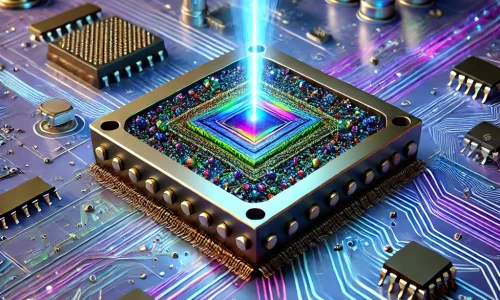Ferroelectric Quantum Semiconductors: The Game-Changer for AI and Robots

You’ve probably heard the buzz around AI and robots, right? They’re showing up everywhere, from the latest tech gadgets to big headlines about self-driving cars. But here’s the thing: what’s really going to make all that cool stuff work even better? It’s a little-known technology that sounds a bit like science fiction—but trust me, it’s real. I’m talking about ferroelectric quantum semiconductors. Yeah, I know, it sounds like something out of a sci-fi novel, but this tech could totally change the way AI and robots work. Here’s why.
Wait, What’s a Ferroelectric Quantum Semiconductor?
Let’s slow down for a second and break it down.
At the simplest level, ferroelectric materials are materials that “remember” the direction of an electric field. Imagine a magnet that stays pointing north, even after you remove the magnetic field. Now, mix in a bit of quantum mechanics (yeah, I know, it’s a little mind-bending), and you get ferroelectric quantum semiconductors—materials that can handle information in a totally different way than traditional semiconductors. They’re faster, more efficient, and can store more data, all at the same time.
Now, don’t worry—I’m not going to dive into a bunch of technical mumbo jumbo. The takeaway is this: these new semiconductors are like a turbocharger for AI and robotics. They give them the power to think faster, adapt quicker, and do more with less energy. And that, my friend, is a big deal.
Why Should We Be Excited About This?
So you’re probably wondering, “Alright, sounds cool, but how does this actually change anything?” Well, let’s take a closer look at how these semiconductors could affect two of the biggest tech trends today: AI and robotics.
AI That Doesn’t Keep You Waiting
You’ve probably interacted with AI in some way—whether it’s through Siri, Netflix recommendations, or your favorite video game. But the truth is, even the smartest AI systems still have limitations. They need to process tons of data, and that can take time.
With ferroelectric quantum semiconductors, this bottleneck is no longer an issue. These materials can process information way faster than the semiconductors we use now. So, instead of waiting for your AI assistant to process your request, imagine it just happens instantly. It’s like upgrading your old smartphone to one that’s lightning-fast and never lags. Pretty sweet, right?
Robots That Learn and Adapt
If you’ve ever seen a robot try to do something complicated—like move through a crowded space or solve a problem—you know they can be a little… slow. Robots are great at following instructions, but they’re still figuring out how to act like humans do: adapting to new situations quickly.
Ferroelectric quantum semiconductors could help robots think and learn faster. Imagine this: A robot in a warehouse is sorting packages. With these semiconductors, the robot can process all the data from its sensors instantly, and adjust its actions without taking a pause. It can learn from its environment, adapt to obstacles, and work more autonomously. Basically, robots will get way better at “thinking on their feet.” How cool is that?
And don’t forget about efficiency. These semiconductors use less energy, which means robots can work longer without needing to recharge. That’s huge in industries like healthcare, where robots assist with surgeries or patient care and need to keep running without interruption.
Faster Data, Better Decisions
Let’s be real: everything in tech today depends on data. From how AI learns to how robots react, it’s all about how fast they can process information. The problem with current tech? Sometimes that data takes too long to process. It’s like trying to download a huge file over a slow internet connection—everything just takes longer than it should.
That’s another place where ferroelectric quantum semiconductors come in. They can process data in real-time, meaning AI can make decisions faster and robots can adjust to new information without missing a beat. Imagine a robot in a hospital that needs to deliver medicine. If the robot can process data faster, it can adjust its path to avoid obstacles or update its route if new information comes in (like an emergency situation).
In short, these semiconductors could make everything—faster, smarter, and more efficient. And who doesn’t want that?
Is This Really the Future, or Just a Hype?
I know, it sounds amazing, but you’re probably wondering: when is all this going to happen? Well, it’s not quite here yet, but it’s definitely on the horizon. Ferroelectric quantum semiconductors are still in the research phase, and there are a few kinks to work out. For example, researchers are still figuring out how to stabilize these materials so they can be used in real-world devices.
But here’s the thing: the potential is undeniable. In the next few years, we’re likely to see this technology start to show up in AI systems and robots, making them faster, smarter, and way more efficient.
Why You Should Care About This?
I get it—tech talk can be a little dry. But here’s why you should care about ferroelectric quantum semiconductors: they’re going to make the future of AI and robotics way more exciting. This isn’t just about making gadgets cooler; it’s about changing the way machines interact with the world. Whether it’s a robot that works alongside you or an AI that helps solve critical problems, this technology is the key to the next big leap.
So, even if you’re not into quantum mechanics (I don’t blame you), you’ll want to keep an eye on this. The tech world is changing fast, and ferroelectric quantum semiconductors are going to play a big part in that change. It might not be tomorrow, but it’s coming—and it’s going to be awesome.